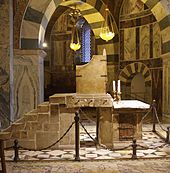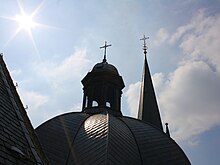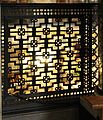
Romanesque architecture is an architectural style of medieval Europe that was predominant in the 11th and 12th centuries. The style eventually developed into the Gothic style with the shape of the arches providing a simple distinction: the Romanesque is characterized by semicircular arches, while the Gothic is marked by the pointed arches. The Romanesque emerged nearly simultaneously in multiple countries ; its examples can be found across the continent, making it the first pan-European architectural style since Imperial Roman architecture. Similarly to Gothic, the name of the style was transferred onto the contemporary Romanesque art.

Cathedrals, collegiate churches, and monastic churches like those of abbeys and priories, often have certain complex structural forms that are found less often in parish churches. They also tend to display a higher level of contemporary architectural style and the work of accomplished craftsmen, and occupy a status both ecclesiastical and social that an ordinary parish church rarely has. Such churches are generally among the finest buildings locally and a source of regional pride. Many are among the world's most renowned works of architecture. These include St Peter's Basilica, Notre-Dame de Paris, Cologne Cathedral, Salisbury Cathedral, Antwerp Cathedral, Prague Cathedral, Lincoln Cathedral, the Basilica of Saint-Denis, Santa Maria Maggiore, the Basilica of San Vitale, St Mark's Basilica, Westminster Abbey, Saint Basil's Cathedral, Antoni Gaudí's incomplete Sagrada Família and the ancient cathedral of Hagia Sophia in Istanbul, now a mosque.

Aachen Cathedral is a Catholic church in Aachen, Germany and the seat of the Diocese of Aachen.

A westwork, forepart, avant-corps or avancorpo is the monumental, often west-facing entrance section of a Carolingian, Ottonian, or Romanesque church. The exterior consists of multiple stories between two towers. The interior includes an entrance vestibule, a chapel, and a series of galleries overlooking the nave. A westwork is usually broader than the width of the nave and aisles. It is sometimes used synonymously with narthex. Charlemagne dreamt of reviving the Roman Empire in the West. His dream along with his artistic skillset allowed him to implement artwork into buildings with westwork during this time period and can be found in the Corvey Abbey and scattered throughout other westwork buildings today.

Pre-Romanesque art and architecture is the period in European art from either the emergence of the Merovingian kingdom in about 500 AD or from the Carolingian Renaissance in the late 8th century, to the beginning of the 11th century Romanesque period. The term is generally used in English only for architecture and monumental sculpture, but here all the arts of the period are briefly described.

Carolingian art comes from the Frankish Empire in the period of roughly 120 years from about 780 to 900—during the reign of Charlemagne and his immediate heirs—popularly known as the Carolingian Renaissance. The art was produced by and for the court circle and a group of important monasteries under Imperial patronage; survivals from outside this charmed circle show a considerable drop in quality of workmanship and sophistication of design. The art was produced in several centres in what are now France, Germany, Austria, northern Italy and the Low Countries, and received considerable influence, via continental mission centres, from the Insular art of the British Isles, as well as a number of Byzantine artists who appear to have been resident in Carolingian centres.

Ottonian art is a style in pre-romanesque German art, covering also some works from the Low Countries, northern Italy and eastern France. It was named by the art historian Hubert Janitschek after the Ottonian dynasty which ruled Germany and Northern Italy between 919 and 1024 under the kings Henry I, Otto I, Otto II, Otto III and Henry II. With Ottonian architecture, it is a key component of the Ottonian Renaissance. However, the style neither began nor ended to neatly coincide with the rule of the dynasty. It emerged some decades into their rule and persisted past the Ottonian emperors into the reigns of the early Salian dynasty, which lacks an artistic "style label" of its own. In the traditional scheme of art history, Ottonian art follows Carolingian art and precedes Romanesque art, though the transitions at both ends of the period are gradual rather than sudden. Like the former and unlike the latter, it was very largely a style restricted to a few of the small cities of the period, and important monasteries, as well as the court circles of the emperor and his leading vassals.
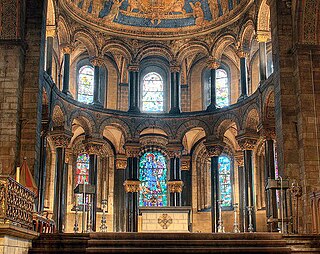
Mosan art is a regional style of art from the valley of the Meuse in present-day Belgium, the Netherlands, and Germany. Although in a broader sense the term applies to art from this region from all periods, it generally refers to Romanesque art, with Mosan Romanesque architecture, stone carving, metalwork, enamelling and manuscript illumination reaching a high level of development during the 11th, 12th and 13th centuries.

Hildesheim Cathedral, officially the Cathedral of the Assumption of Mary or simply St. Mary's Cathedral, is a medieval Roman Catholic cathedral in the city centre of Hildesheim in Lower Saxony, Germany, that serves as the seat of the Diocese of Hildesheim. The cathedral has been on the UNESCO World Cultural Heritage list since 1985, together with the nearby St. Michael's Church because of its unique art and outstanding Romanesque architecture.

Ottonian architecture is an architectural style which evolved during the reign of Emperor Otto the Great. The style was found in Germany and lasted from the mid 10th century until the mid 11th century.

Germigny-des-Prés is a commune in the Loiret department in north-central France.

Carolingian architecture is the style of north European Pre-Romanesque architecture belonging to the period of the Carolingian Renaissance of the late 8th and 9th centuries, when the Carolingian dynasty dominated west European politics. It was a conscious attempt to emulate Roman architecture and to that end it borrowed heavily from Early Christian and Byzantine architecture, though there are nonetheless innovations of its own, resulting in a unique character.
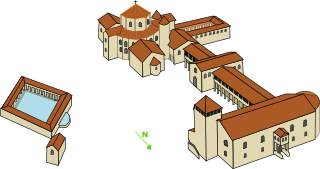
The Palace of Aachen was a group of buildings with residential, political, and religious purposes chosen by Charlemagne to be the center of power of the Carolingian Empire. The palace was located north of the current city of Aachen, today in the German Land of North Rhine-Westphalia. Most of the Carolingian palace was built in the 790s but the works went on until Charlemagne's death in 814. The plans, drawn by Odo of Metz, were part of the program of renovation of the kingdom decided by the ruler. Today much of the palace is ruined, but the Palatine Chapel has been preserved and is considered a masterpiece of Carolingian architecture and a characteristic example of architecture from the Carolingian Renaissance.
Imperial cathedral is the designation for a cathedral linked to the Imperial rule of the Holy Roman Empire.

Essen Minster, since 1958 also Essen Cathedral is the seat of the Roman Catholic Bishop of Essen, the "Diocese of the Ruhr", founded in 1958. The church, dedicated to Saints Cosmas and Damian and the Blessed Virgin Mary, stands on the Burgplatz in the centre of the city of Essen, Germany.

Eudesof Metz was an architect of Armenian origin who lived during Charlemagne's reign in the Carolingian Empire. He is the earliest known architect born north of the Alps.

The Barbarossa Chandelier was made on the order of Emperor Frederick I, nicknamed Barbarossa, and his wife Beatrice sometime between 1165 and 1170 and was installed under the cupola of the Palatine Chapel in Aachen Cathedral. The chandelier was a donation in honour of Mary, Mother of God, the patroness of Aachen Cathedral and simultaneously represented a tribute to the builder of the cathedral, Charlemagne.

The Throne of Charlemagne is a throne erected in the 790s by Charlemagne, as one of the fittings of his palatine chapel in Aachen and placed in the Octagon of the church. Until 1531, it served as the coronation throne of the King of the Romans, being used at a total of thirty-one coronations. As a result, especially in the eleventh century, it was referred to as the totius regni archisolium. Charlemagne himself was not crowned on this throne, but instead in the Old St. Peter's Basilica in Rome by Pope Leo III in 800 AD.
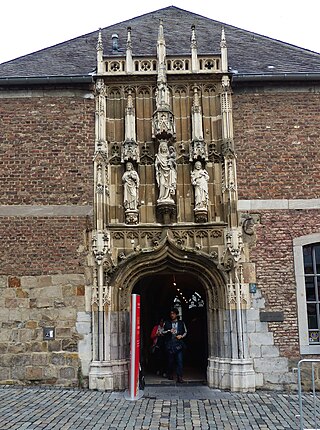
The Aachen Cathedral Treasury is a museum of the Roman Catholic Diocese of Aachen under the control of the cathedral chapter, which houses one of the most important collections of medieval church artworks in Europe. In 1978, the Aachen Cathedral Treasury, along with Aachen Cathedral, was the first monument on German soil to be entered in the List of UNESCO World Heritage Sites. The treasury contains works from Late Antique, Carolingian, Ottonian, Staufen, and Gothic times. The exhibits are displayed in premises connected to the cathedral cloisters.
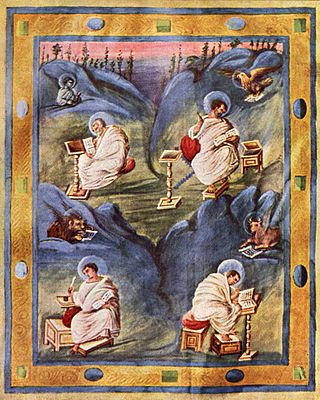
The Aachen Gospels are a Carolingian illuminated manuscript which was created at the beginning of the ninth century by a member of the Ada School. The Evangeliary belongs to a manuscript group which is referred to as the Ada Group or Group of the Vienna Coronation Gospels. It is part of the church treasury of Charlemagne's Palatine Chapel, now Aachen Cathedral, and is today kept in the Aachen Cathedral Treasury. The Treasury Gospels and the more recent Ottonian Liuthar Gospels are the two most significant medieval manuscripts on display there.


